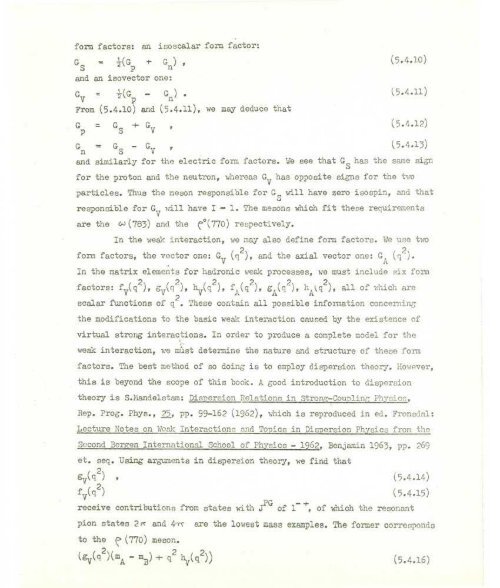introduction-weak-interaction-volume-one
introduction-weak-interaction-volume-one
introduction-weak-interaction-volume-one
Create successful ePaper yourself
Turn your PDF publications into a flip-book with our unique Google optimized e-Paper software.
form factors : an isoscalar fora factor :<br />
G S - -}(Gp + G n ) , (5 .4 .10 )<br />
and an isovector <strong>one</strong> :<br />
i- ( Gp - Gn ) . (5 .4 .11 )<br />
Gv =<br />
From (5 .4 .10) and (5 .4 .11), we may deduce that<br />
G<br />
P<br />
= GS + Gv , (5 .4 .12 )<br />
G n = GS - Gv , (5 .4 .13 )<br />
and similarly for the electric form factors . We see that G S has the same sign<br />
for the proton and the neutron, whereas<br />
Gv has opposite signs for the two<br />
particles . Thus the meson responsible for G S will have zero isospin, and tha t<br />
responsible for G v will have I = 1 . The mesons which fit these requirements<br />
are the 6J (783) and the e°(770) respectively .<br />
In the <strong>weak</strong> <strong>interaction</strong>, we may also define form factors . We use two<br />
form factors, the vector <strong>one</strong> : Gv ( q2 ), and the axial vector <strong>one</strong> : GA ( q 2 ) .<br />
In the matrix elements for hadronic <strong>weak</strong> processes, wo must include six for m<br />
factors : fv(g2 ), gv( g2 ), hv( g2), fA(g2), gA(g 2 ), h A (g2 ), all of 'which ar e<br />
scalar functions of<br />
q 2 . These contain all possible information concernin g<br />
the modifications to the basic <strong>weak</strong> <strong>interaction</strong> caused by the existence o f<br />
virtual strong <strong>interaction</strong>s . In order to produce a complete model for th e<br />
<strong>weak</strong> <strong>interaction</strong>, we mast determine the nature and structure of these form<br />
factors . The best method of so doing is to employ dispersion theory. However ,<br />
this is beyond the scope of this book . A good <strong>introduction</strong> to dispersio n<br />
theory is S .Landelstam : Dispersion Nelations in Strong-Coupling Physics ,<br />
Rep . Frog . Phys ., , pp . 99-162 (1962), which is reproduced in ed . Fronsdnl :<br />
Lecture Notes on Posh Interactions and Topics in Dispersion Physics from th e<br />
Second Bergen International School of Physics - 1962, Benjamin 1963, pp . 26 9<br />
et . seq. Using arguments in dispersion theory, we find tha t<br />
gv(g 2) , (5 .4 .14 )<br />
fv(g2 ) (5 .4 .15 )<br />
receive contributions from states with r G of 1 +, of which the resonan t<br />
pion states 2r and 4-T are the lowest mass examples . The former correspond s<br />
to the (770) meson .<br />
(gv(g 2)( mA - m ) + q2 hv (g 2)) (5 .4.16)



